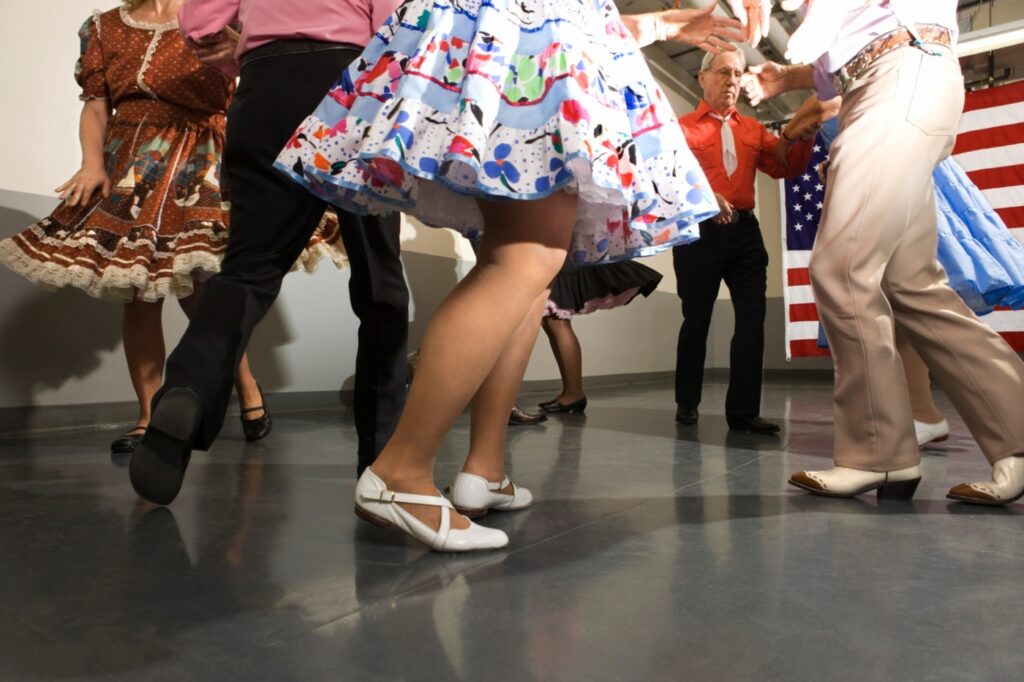
Q. Do you have any information or opinions on how square dancing affects aging? L.D.
Indeed, there is a body of research that examines the impact of square dancing on aging and particularly on cognitive functioning in later life. The findings are positive. Note that dance in almost any form is considered a plus that can significantly improve muscular strength and endurance, balance. This is particularly relevant for older adults.
Here are the results of a few research studies. One led by a Colorado State University researcher shows that “kicking up your heels can actually be good for your noggin.” This was in reference to a study of participants in a dance class, most likely square dancing by its description and the picture accompanying the study. Researchers saw “improved white matter integrity in an area of the brain related to memory and processing speed.” White matter is made up of a large network of nerve fibers that allows the exchange of information and communication between different areas of your brain. That broadly translated into improved cognitive functioning.
Square dancing is an emerging form of aerobic exercise in China, especially among middle-aged and older people. In reviewing the results of 24 studies, researchers explored the effects of square dancing on the physical and mental health among Chinese older adults. The results indicated significantly lower risk of coronary heart disease and increased leg muscles. A caveat is that there may be some biases in the study according to MDPI, a publisher of peer-reviewed articles.
Another study conducted by West China Hospital, Sichuan University found that among approximately 2600 participants, square dancing was positively correlated with brain function, suggesting that cognitive functioning increased.
Line dancing in particular may be beneficial for cognition since it requires memorizing the choreography as it is danced with others in unison as the song plays. It requires memorizing the moves while with square dancing, the instructions are announced by the caller.
The Better Health Channel owned by the State of Victoria, Australia identified several benefits to dance and specifically included square dancing. Here are just a few: increased muscular strength and endurance; improved strength, stronger bones, better coordination and agility and improved balanced. Add to that improved mental functioning, greater confidence and self-esteem as well as better social skills.
Square dancing is related to mathematics according to Krin Rabe and Gre Morre, both theoretical physicists who combine their passion for math and modern Western square dance. Both are callers and dancers. They explore the underlying mathematical structures in this form of dance and presented this as a topic for a seminar they conducted.
I recently had a conversation with Carol, aged 78, who spends time square dancing averaging about 15 hours or more over a five-day period. She finds it exhilarating and never wants to miss a class. Here are some additional benefits she has experienced. “Square-dancing helps me think clearly given that it involves math. It gives me a chance to work with different people, often requiring patience while developing new interpersonal skills. Since it’s social have made lots of new friends.” She also finds square dancing helps her memory since she has to memorize the calls and remember the sequence, particularly in line dancing. The physical activity keeps her body in perfect shape and consequently doesn’t feel stale or old, she added. Her final comment: “If I am going to go, it’s on the dance floor with a smile on my face.”
For those of us who are new to square dancing, writer Tyler Hughes wrote a helpful piece about it, which I am sourcing: Here are some facts that may entice some of us to try it:
Square dances are forgiving. There typically is a beginner’s floor so folks don’t have to be afraid or be embarrassed. Also, it is not competitive.
There generally is no dress code. Cowboy boots typically are not required nor are gingham shirts or cowboy hats.
Square dancing is for everyone. There is no concern about dancing with partners of the same sex. Welcoming organizations include International Association of Gay Square Dance Clubs and the U.S. Handicapable Square Dance Association.
Square dances are everywhere. In the early 2000s, nearly every city in the United States had at least one square dance club with larger cities having two or more.
Square dancing is fun. That’s it! It’s a great way to connect with others with no technological filter.
Thank you L.D. Your question may inspire some of us to engage in a new physical activity that is fun, social, helps with cognition and overall functioning.
Stay well everyone and be kind to yourself and others—on and off the dance floor.
Helen Dennis is a nationally recognized leader on issues of aging and the new retirement with academic, corporate and nonprofit experience. Contact Helen with your questions and comments at Helendenn@gmail.com. Visit Helen at HelenMdennis.com and follow her on facebook.com/SuccessfulAgingCommunity
